At the end of 2022, I had the pleasure of collaborating with Semmelweis University in Hungary on the largest ever study of intraoral scanners on an international scale.
We called upon our community of digital dentists, techs, and DA's, and we are so very grateful that so many of you answered.
Thank you. To each one of you that filled out the survey. Thank you!
We surveyed 1072 people and gathered some really interesting data on the IOS market that has been officially published in the International Dental Journal.
It's incredible to see how digital dentistry has blossomed from a fairly niche area of dentistry, into the gold-standard across the industry.
You can read the full study here. We have summarized some interesting stats - as well as our insights - below.

Results of the survey
Where were the respondents from?
Our study received a total of 1751 responses. However, we had to exclude 38.8% (n=679) of these responses. The exclusions were made for various reasons, including administrative staff (5.5%, n=96), industry experts (4.6%, n=80), and office staff (0.9%, n=16) who were not part of the dental community. Additionally, partially completed questionnaires accounted for 33.3% (n=583) of the exclusions.
Ultimately, we analyzed a total of 61.2% (n=1072) of the responses, which came from participants in 109 different countries.
The top five countries represented in our study were India (17.4%, n=186), the United States (11.4%, n=122), Egypt (4.9%, n=52), Australia (4%, n=43), and Canada (3.9%, n=42; see Figure 1).
Among these respondents:
- 75.8% (n=813) were general dentists
- 16.2% (n=174) were dental specialists
- 4.7% (n=50) were dental technicians
- 2.3% (n=25) were dental students
- 0.7% (n=7) were dental assistants
- 0.3% (n=3) were dental hygienists
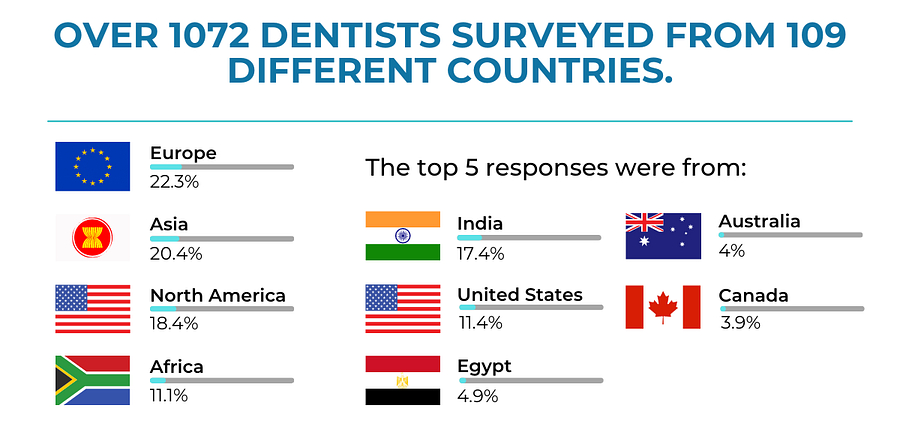
Accuracy of Intraoral Scanners
An overwhelming 81.9% (n=878) of the participants believed that current technology makes intraoral scanners (IOS) more accurate compared to traditional casting methods, while 18.1% (n=194) expressed a preference for traditional casting.
Only 0.9% (n=10) of the respondents believed that digital technology will not become more accurate in the future.
A significant majority of the participants (78.8%; n=845) reported using IOS in their daily work, while 21.2% (n=227) had not used it.
Of those who responded, 78.8% (n=845) use their intraoral scanner daily, 17.9% (n=151) had been using it for over 5 years, 12.9% (n=109) for 3 to 5 years, 34.3% (n=290) for 1 to 3 years, 25.3% (n=214) for less than 1 year, and 9.6% (n=81) for less than 1 month.


This shows that intraoral scanners are quickly becoming the industry standard for taking impressions, and the majority of dentists who were surveyed have already opted into implementing digital dentistry in their clinic.
On average, the respondents owned 1.5 scanners (±0.9).
While 24.7% (n=209) considered themselves experts and 29.6% (n=250) beginners in the use of IOS technology, 45.7% (n=386) identified as intermediate-level users.
A significant majority (85.6%; n=723) utilized digital impressions with IOS for fabricating fixed prosthetic appliances.

Computer-Aided Design Software
More than one-third of the participants (38.62%; n=414) performed computer-aided design (CAD) using in-house software.
We've long been advocates for using CAD software in your dental clinic, so it's great to see that there's a portion of dentists out there giving it a go.
In a time where saving money and reducing costs is becoming more important - while still providing optimal care to your patients - CAD software is an amazing tool in your arsenal to have to ensure you have full control of your dental workflow.
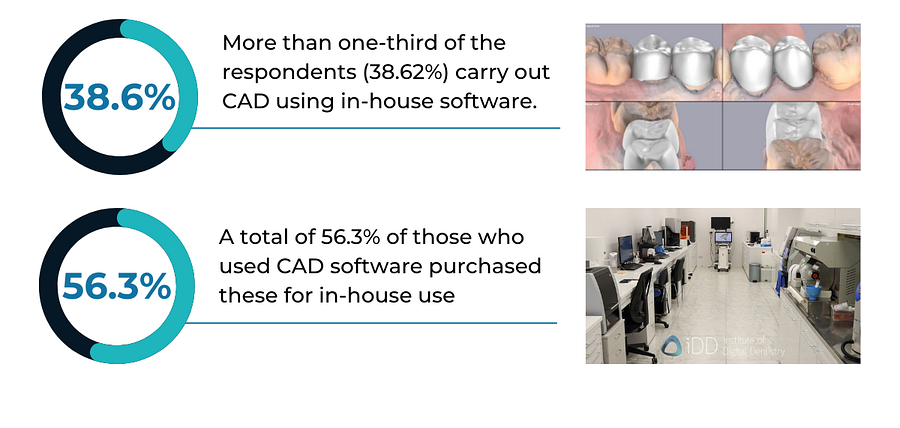
The costs of the software varied significantly, ranging from free software provided by certain distributors to over US$20,000.
Costs below in USD.

Among the CAD users, 40.3% (n=94) reported being able to upgrade their software for free.
Interestingly, 31.5% of the respondents (n=338) had in-house computer-aided manufacturing (CAM) tools, with 11.8% (n=126) owning both a milling machine and a 3D printer.
Additionally, 9.8% (n=105) had only a milling machine, while 10% (n=107) had only a 3D printer.

As you can see in the graph below, exocad was the most popular CAD software used by those who completed the survey, closely followed by CEREC and 3Shape software.
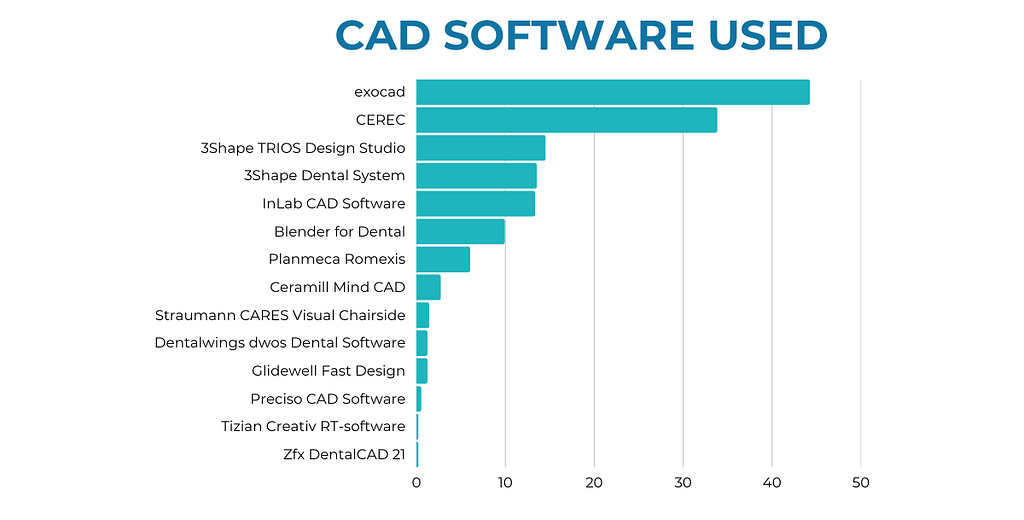
Brands of intraoral scanners used by dentists
In total, the respondents reported using 36 different intraoral scanners, you can see the top rated in the table below.
The survey participants ranked all the scanners out of 5 on things like speed, support, accessibility, and price.
Rankings based on Survey Results
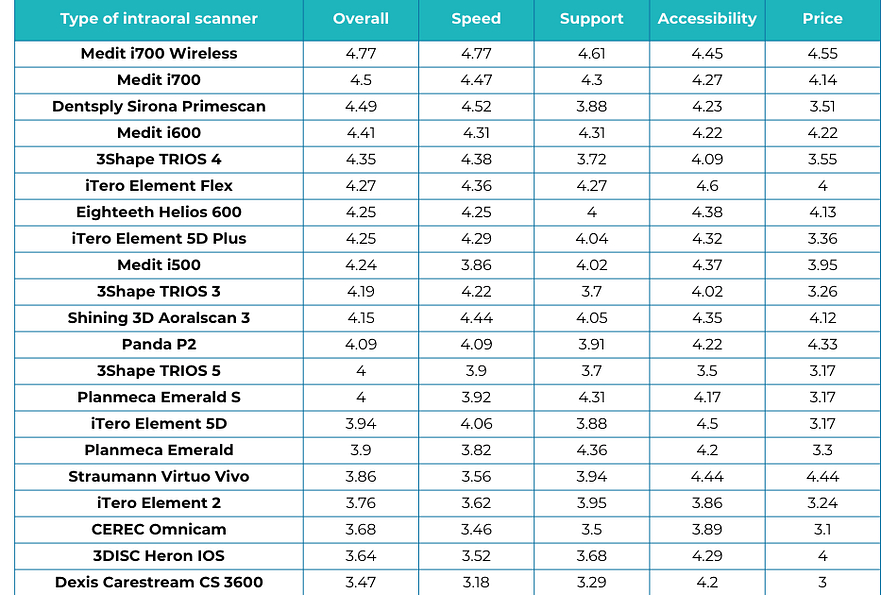
Compare The IOS Market - In One Document
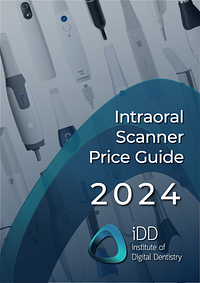
Cost is the number one barrier for all clinicians who want to start getting into digital dentistry and intraoral scanning. That is a proven fact.
To help you navigate all the numbers, we have outlined the prices of some of the latest scanners available.
Overall, based on the survey results the top three scanners in terms of satisfaction were
- Medit i700 wireless (4.77),
- Medit i700 (4.5), and
- Dentsply Sirona's Primescan (4.49).
In regards to support - Medit i700 wireless was rated the highest (4.61), followed by Planmeca Emerald (4.36), and Medit i500 (4.31). Devices with fewer than 10 assessments were excluded from the hierarchy rankings.
In terms of accessibility, iTero Element Flex (4.6), iTero Element 5D (4.5), and Medit i700 wireless (4.45) were considered the best.
Regarding price satisfaction, the top three scanners were Medit i700 wireless (4.55), Straumann Virtuo Vivo (4.44), and Panda P2 (4.33).
The respondents also identified the main disadvantages of their chosen devices, with price being the most commonly mentioned (29.8%, n=333), followed by scan speed (13.9%, n=155), software quality (10.3%, n=115), support service (8%, n=89), and the training course provided (7.1%, n=80).
On the other hand, 17.6% (n=197) of users indicated that they found no major disadvantages and were satisfied with their purchased IOS.
Additionally, the respondents provided information about their annual costs related to maintaining their IOS .
The majority (53.1%, n=595) reported no maintenance costs, while 5.3% (n=60) spent between US$101 and US$250, 5.9% (n=66) spent between US$251 and US$500, 7.51% (n=84) spent between US$500 and US$1000, 8.31% (n=93) spent between US$1001 and US$2000, 9.4% (n=106) spent between US$2001 and US$5000, and 2.5% (n=28) spent more than US$5000 on maintaining their IOS.
A detailed breakdown can be found in the supplementary data.
Regarding the frequency of IOS usage among the participants, 49.5% (n=554) used the system on a daily basis, 27.1% (n=303) used it 2 to 3 times per week, 9.7% (n=108) used it once a week, 4.6% (n=51) used it 2 to 3 times a month, 3.6% (n=40) used it once a month, and 5.6% (n=63) used it less than once a month.
Reasons for purchasing an intraoral scanner
A significant majority of the respondents, 68.6% (n=768), actively participated in the purchase of their intraoral scanners (IOS), and 40.1% (n=457) of them underwent education or courses prior to making the purchase.
The main reasons for selecting a particular scanner were:
- Recommendations from colleagues (26.2%, n=201)
- Perceived accuracy of the system (19.4%, n=149)
- The brand of the IOS (16%, n=123)
- Price (15.8%, n=121)
- Software design (14.5%, n=111)
- Miscellaneous reasons were mentioned by 8.2% (n=63) of the respondents

Conclusion
In summary, this questionnaire study provides valuable insights into the international use of IOS technology in dentistry. The findings reveal that IOS has become a common and routine tool in dental practice, with a majority of respondents using it on a daily basis. The study emphasizes the need for proper education and training to ensure optimal utilization of IOS devices and effective management of their various functions.
One notable aspect highlighted by the research is the diverse range of IOS scanner systems and software available worldwide. With over 35 different systems reported by respondents, the lack of uniformity poses challenges in terms of compatibility and communication between devices. This underscores the importance of industry attention towards developing open and compatible systems that facilitate seamless integration and enhance workflow efficiency.
The study also sheds light on the maintenance costs associated with IOS systems, which vary significantly across countries and even within the same country. Factors such as frequency of use and the specific brand of IOS play a role in determining these costs. It is essential for dental professionals to consider these factors when making purchasing decisions. Further comparative studies should be conducted to provide comprehensive and relevant data to the dental community, beyond what is provided solely by manufacturers.
Overall, this research highlights the widespread adoption of IOS technology in dentistry and its potential for further advancements in the future.
It's clear that intraoral scanners are now accepted as the standard for impression taking across the dental industry. We're proud to be at the forefront of digital dentistry by reviewing every intraoral scanner on the market and reporting on the latest advancements.
Once again, thank you to everyone who participated in the study. If you'd like to read the study in its entirety, click the button below.

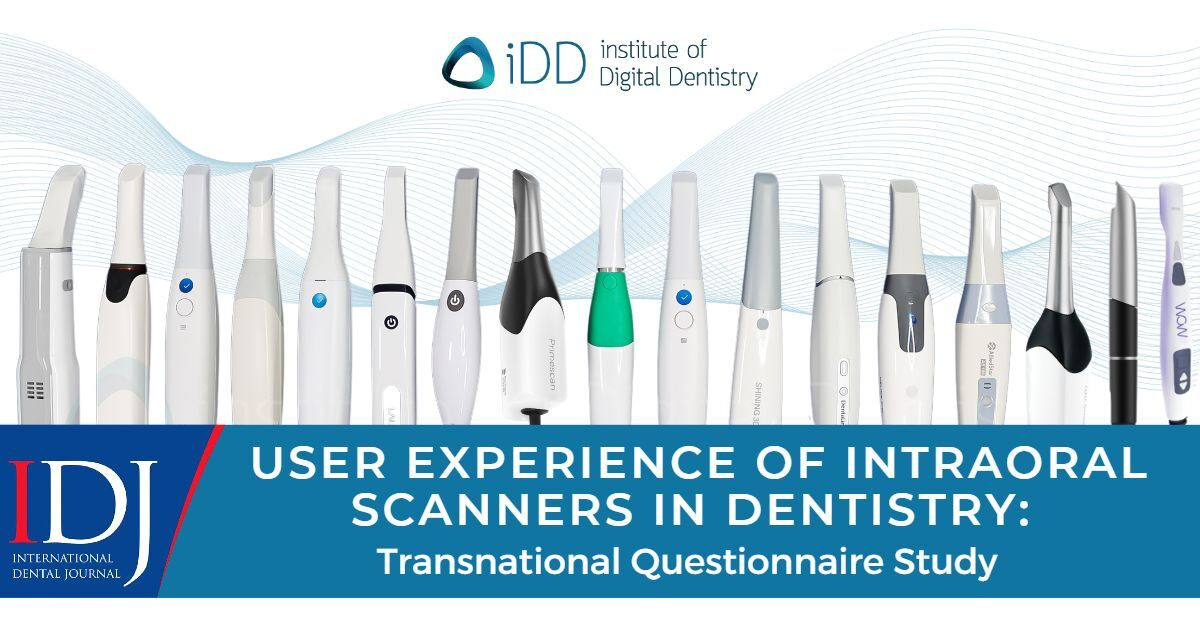
Superb job IDD is one of the most amazing learning platform in the field of dentistry throughout the world I have learnt a lot of things in few days and will keep learning ahead these courses will help me to become a professional in my field and to serve humanity in a better way in my practice. Thanks!
Thank you Kamran for the kind words. Means a lot to me and the iDD team!